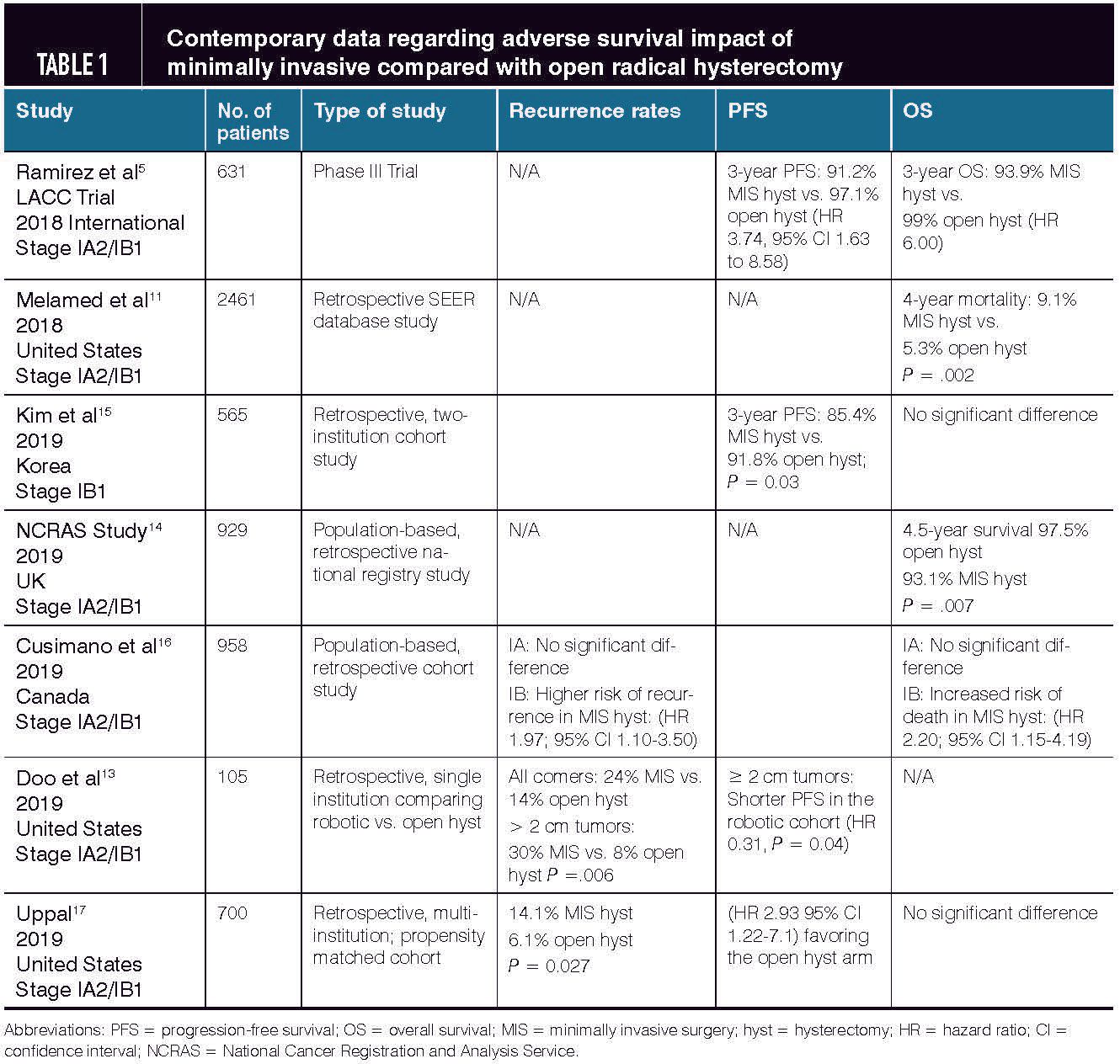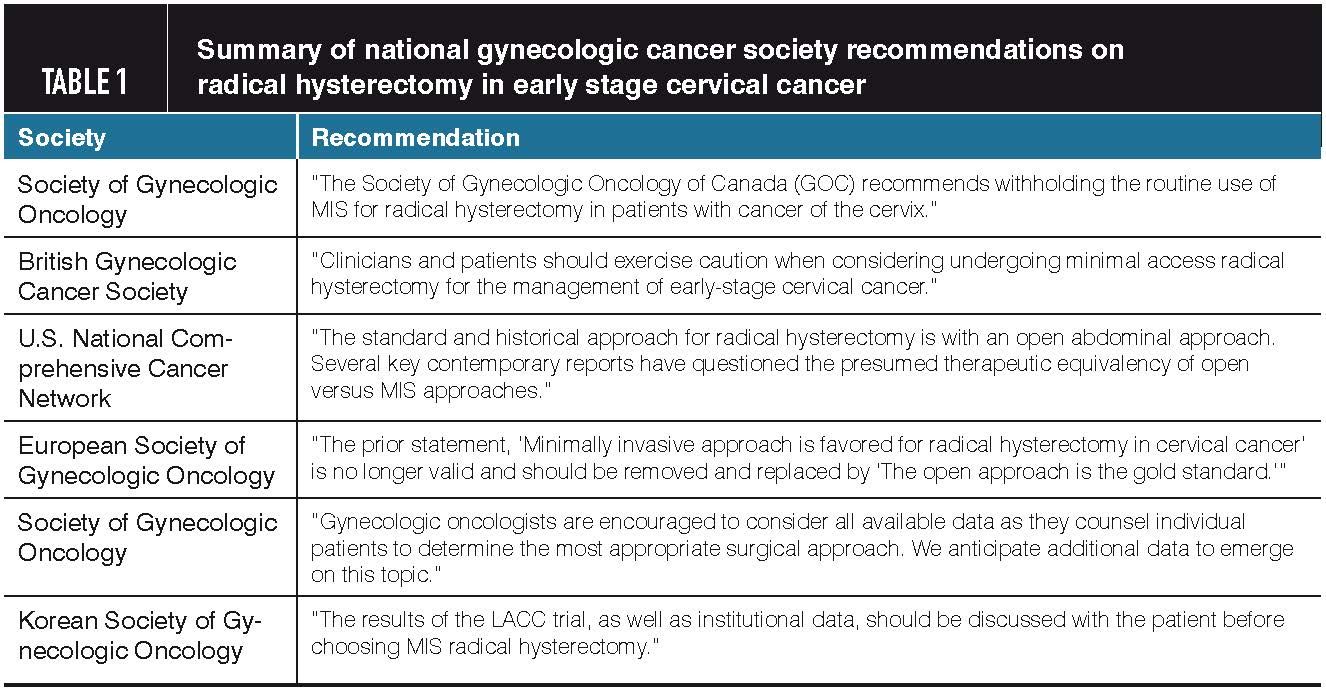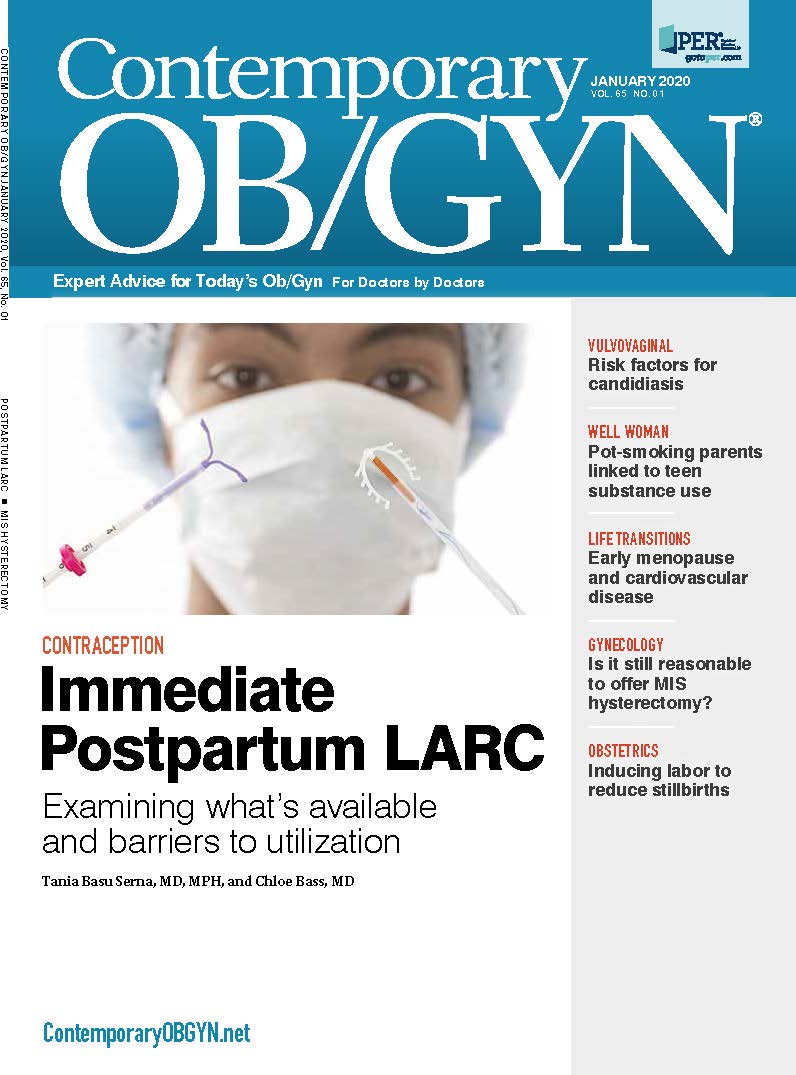Is it still reasonable to offer MIS hysterectomy? No.
Two ob/gyns provide arguments for and against offering the procedure. This article, from Dr. Fader, covers the con side of the argument.
©Gajus - stock.adobe.com

Cervical cancer is among the most frequently diagnosed malignancies and the fourth leading cause of cancer-related death in women, with 570,000 new cases and 311,000 deaths anticipated worldwide in 2019. Despite decades of Pap smear screening, human papillomavirus (HPV) co-testing, and the recent availability of the HPV vaccine, cervical cancer and its precursor, cervical dysplasia, remain a significant public health threat for women worldwide.
In women with early-stage cervical cancer, surgery is indisputably the treatment with the most positive impact on long-term survival. Standard radical hysterectomy and pelvic lymphadenectomy, which are performed through either a transverse or vertical abdominal incision, are associated with the potential for procedural morbidity and patient recovery time. More than a decade ago, however, a new approach to gynecologic cancer surgery was welcomed by surgeons with the Phase III Gynecologic Oncology Group LAP2 trial, a study which demonstrated significant perioperative benefits and almost identical survival outcomes for laparoscopic compared with open hysterectomy in patients with early-stage uterine cancer. Because of outcomes in this and other trials, gynecologic oncologists endeavored to expand the indications for minimally invasive surgery (MIS), including in cervical cancer. Based on subsequent retrospective data touting superior perioperative results and similar oncologic outcomes compared with open approaches, minimally invasive radical hysterectomy was embraced by gynecologic oncology surgeons worldwide for treatment of stage IA2-IB1 cervical cancer.
However, recently, Ramirez and colleagues reported the results of the Laparoscopic Approach in Cervical Cancer (“LACC”) study in the New England Journal of Medicine, the first-and only-Phase III trial addressing the relationship between surgical approach and survival outcomes in early-stage cervical cancer. A total of 631 patients with early-stage squamous cell tumors or adenocarcinomas were randomized to undergo either an open or minimally invasive radical hysterectomy. Midway through this non-inferiority trial, the Data Safety and Monitoring Committee identified a disproportionate number of deaths in the minimally invasive cohort, triggering study closure after an interim analysis revealed inferior disease-free survival at 4.5 years, as well as significantly higher death rates, in the minimally invasive compared to the open hysterectomy cohort. These striking and surprising results were paradigm shifting and raised serious concerns regarding the safety of performing minimally invasive radical hysterectomy.
Critics question the results and ask “why?” and “how?”
Many have questioned how the unanticipated results of the LACC trial could be so incongruous with prior published data. In journal editorials and at national society meetings, minimally invasive enthusiasts and thoughtful gynecologic oncology critics have voiced concerns over perceived trial weaknesses that may limit conclusions. As a surgeon who has studied minimally invasive innovations and performed countless robotic and laparoscopic cancer staging procedures in my career, I was astonished with the LACC trial results, and my voice was among the chorus of critics focused on the trial limitations and urging others that it was premature to sound the death knell for MIS in cervical cancer. I wondered:
- “How can MIS be so dangerous for women with early-stage cervical cancer when we have not observed similar trends in those with early-stage endometrial cancer?”
- “There is no definitive explanation to account for these findings, so what do we make of them?”
- “Why are the LACC trial results seemingly so different than other retrospective studies?”
- “Are the study surgeons using irresponsible techniques or is lack of experience an issue?”
However, after conducting a comprehensive trial analysis and reviewing the many studies that have emerged since the LACC trial publication, my early view on this matter has shifted considerably to one of sober appreciation of these data and an understanding that we could not continue as we had before in our surgical approach to cervical cancer. Herein, I will discuss dilemmas with conducting surgical trials, critically appraise the LACC trial strengths and limitations, review the existing literature on early-stage cervical cancer survival outcomes by surgical approach, and present an argument on why it may be time for the “old” radical hysterectomy technique to become relevant again.
The problem with surgical innovation and trials
Surgical innovation is important, and as technology expands, there is increasing pressure on surgeons to incorporate the latest surgical procedures and tools into their practices. However, with that incorporation must come rigorous evaluation. The cervical cancer story shows us that evidence from retrospective case series alone may no longer be acceptable as the only evaluation of a surgical approach, and that procedures-especially those used to treat life threatening conditions like cancer-must be evaluated robustly in randomized controlled trials (RCTs). The Phase III study is the gold standard in this regard, and the power of this study type is its rigorous design which minimizes risk of random or systematic bias/error, and thus, the risk of making an incorrect conclusion about the efficacy of a treatment. Despite this, surgical trials are notoriously difficult to conduct and pose particular practical and methodological challenges. The RCT has been widely accepted for evaluating the efficacy of medical treatments but less so for surgical procedures. Critics cite methodologic issues related to surgery as the reason, including concerns related to standardization of the surgical procedure, challenges of or inability to performing blinding of subjects and investigators, variability of surgeon experience with a given procedure, patient differences, and patient and surgeon acceptance of surgical trials.
The LACC trial is not immune to these concerns and several limitations have been cited, including:
- a lack of central pathology review and standardization of adjuvant therapies after radical hysterectomy;
- a concern for variability in surgeon experience with open and minimally invasive radical hysterectomy and that most of the recurrences came from a select number of study sites;
- the fact that cervical cancer surgery is technically complex, and patient, surgeon and procedural variables may all impact trial outcomes;
- missing patient data; and
- subjective patient evaluations without standardized preoperative imaging.
These trial biases are legitimate and will be discussed below; however, what critics fail to mention is that the same study flaws are augmented even further in the smaller, retrospective published studies that preceded the LACC trial.
With regards to the study recurrences, which were largely grouped at 14 of the 33 participating cancer centers, this can be explained, in part, by the fact that several of these particular centers enrolled more patients and became study sites earlier than other centers without recurrences. Whether unique patient or surgeon factors contributed to the institutional pattern of recurrence is unknown. However, the trial was enriched with gynecologic oncology surgeons who were laparoscopic/robotic experts, and were vetted based on their expertise in minimally invasive-not open-radical hysterectomy skills. On the subject of missing data, the authors report that only 8% of trial data were missing at the final analysis, which is within the industry standard range for missing data in RCTs. And while postoperative treatment was not standardized, use of adjuvant radiation and chemotherapy was well balanced between the surgical cohorts.
Perhaps one of the most provocative LACC trial results was that the minimally invasive cohort did not necessarily experience poorer disease-free survival (DFS) than predicted (86%) based on a prespecified DFS of 90% at 4.5 years and a 7.2% equivalence margin. Instead, the open hysterectomy cohort had higher-than-expected DFS (96.5%).
Some argue that while MIS appears inferior to open radical hysterectomy in the LACC trial, the treatment effect estimated from the historical experience with the control arm was ultimately erroneous and the constancy assumption of the trial (the assessment of likelihood that the current control arm effect is similar to the past effect) was not upheld. In other words, the observed non-inferiority boundary is only meaningful if the constancy assumption is sustained; therefore, if the open cohort results are indeed anomalous in terms of what was predicted, then the study conclusions are undermined. However, this argument does not stand for several reasons. While the open hysterectomy cohort had higher-than-expected DFS results compared to older clinical trials, some of these prior studies contained patients at a much higher baseline risk of recurrence. In addition, several more contemporary, retrospective analyses (several discussed in this editorial) show similar survival trends as the LACC trial. Most importantly, the trial’s Data Safety and Monitoring Committee recommended early closure due to significantly worse mortality noted in the MIS cohort on interim analysis. This mortality signal was so strong that it would have been unethical to keep the trial open in an effort to assess if the prespecified non-inferiority margin was ultimately met. Therefore, the mortality data cannot be dismissed and trumps any minor statistical technicalities.
Online-exclusive table

Table 1

Discrepancy in the pre- vs post-LACC trial data
While surgical trials are difficult to conduct, comparisons of prior randomized and non-randomized studies have shown that results can diverge, both in direction and magnitude. There are countless examples of “effective” surgical treatments being discredited in randomized trial settings. However, findings from alternative (non-randomized) study designs cannot be given the same vote of confidence, due to the substantial risk of bias. And while many surgeons accept the need in principle for randomized studies, they struggle to reconcile their surgical experience and personal beliefs with the actual data. Never has this been more apparent than with the LACC trial. But why did these trial results diverge so much from the data found in previously published literature?
My informal Pubmed review of English language studies with the search terms “cervical cancer” “laparoscopy,” “robotics,” “minimally invasive surgery,” “laparoscopic radical hysterectomy” and “robotic radical hysterectomy” revealed hundreds of studies, which was expected. What I did not anticipate was that the vast majority (~99%) were focused on surgical outcomes only and omitted data on recurrence and survival outcomes. Specifically, most of the data were retrospective, most studies were small and included fewer than 100 patients, and fewer than 0.5% reported on survival (and of these, not a single study was powered for survival outcomes).
In contrast, the literature that has arisen peri- or post-LACC trial has been illuminating. A companion analysis by Melamed and colleagues suggests that the survival outcomes observed in the LACC trial have validity. Using an innovative study design to analyze patients with Stage IA2-IB1 cervical cancer in two population-based, retrospective data sets, the authors determined that overall survival rates dropped significantly and systematically each year after robotic surgery adoption in the United States. These data may, in part, reflect the steep surgeon learning curve for minimally invasive radical hysterectomy and it will be interesting to follow those trends out beyond the initial 4 years presented in this study. In addition, several subsequent international cancer registry and multi-
institutional studies have been published recently showing almost identical survival trends/outcomes as the LACC trial. These studies are presented in the online-exclusive table, and include analyses conducted in the United States, Canada, the United Kingdom, and Korea, among others. Furthermore, given the totality of the emerging data on this issue, the national gynecologic cancer societies/agencies that define standards of care in each of these respective countries have recently issued updated position statements regarding concerns with the minimally invasive radical hysterectomy approach for early stage cervical cancer. Excerpts of these statements are found in Table 1.
Unknowns
What remains unknown is why women with apparent early-stage cervical cancer who undergo MIS radical hysterectomy experience worse survival outcomes than those who undergo open radical hysterectomy. Is the worse mortality observed in the minimally invasive cohorts of the LACC trial, the Melamed et al analysis, and other recent population-based analyses purely a function of surgical modality, or are surgeon technique and learning curve, patient factors, flawed study methodology, or the intersection of all of the above at play? Some suggest that uterine manipulators are the biggest culprit while others implicate CO2 abdominal insufflation or exposure of the cervical tumor to the peritoneal cavity. Surgeon experience and procedural radicality may also impact outcomes, although the surgeons who participated in the LACC trial were vetted for their expertise (apparently by video assessment) with minimally invasive radical procedures. The use of manipulators, surgical extraction techniques and procedural radicality were not reported in the LACC trial, and discerning their impact would potentially be high yield. CO2 gas is not likely the problem, as the patterns of recurrence in the LACC trial are not consistent with aerosolization of tumor cells in the abdomen. In addition, it’s not clear from the LACC trial and other studies whether women with Stage IA2 tumors may safely undergo minimally invasive radical hysterectomy, as these cohorts are underpowered in all of the contemporary analyses. Further studies may help elucidate these questions and identify subgroups of women who will most benefit from minimally invasive approaches.
Conclusions
Every published surgical trial ever performed has limitations, and the LACC trial has its share of flaws. But this is not a reason to avoid conducting randomized procedure-based studies nor to completely dismiss study findings when they are performed-especially when they are the best available data and the results are unexpected and not aligned with our prior beliefs. When considering the collective body of contemporary data on surgical approach in early-stage cervical cancer, minimally invasive radical hysterectomy can no longer be considered the standard surgical procedure for treating Stage IA2 and 1B1 cervical cancer. In select cases, this approach may be appropriate. However, the retrospective and population-based data that have emerged since the LACC trial strongly support the Phase III study findings. Until further data are available, caution should be heeded by clinicians considering minimally invasive surgery in women with early-stage cervical cancer, with rigorous counseling regarding LACC trial results and shared decision-making between the patient and her surgeon with respect to her individual risks and benefits for such a procedure.
Disclosures:
The author reports no potential conflicts of interest with regard to this article.
References:
- Bray F, Ferlay J, Soerjomataram I, et al. Global cancer statistics 2018: GLOBOCAN estimates of incidence and mortality worldwide for 36 cancer in 185 countries. CA Cancer J Clin. 2018 Sep 12. [Epub ahead of print]
- Walker JL, Piedmonte MR, Spirtos NM, et al. Recurrence and survival after random assignment to laparoscopy versus laparotomy for comprehensive surgical staging of uterine cancer: Gynecologic Oncology Group LAP2 Study. J Clin Oncol. 2012;30:695-700.
- Conrad L, Ramirez PT, Burke W et al. Role of minimally invasive surgery in gynecologic oncology: an updated survey of members of the Society of Gynecologic Oncology. Int J Gynecol Cancer. 2015;25:1121–1127.
- National Comprehensive Cancer Network. NCCN Clinical Practice Guidelines in Oncology Cervical Cancer (version I.2018) [Internet]. 2018 [cited 2018 Oct 9]; Available from: https://www.nccn.org/professionals/physician_gls/pdf/cervical.pdf
- Ramirez PT, Frumovitz M, Pareja, R, et al. Minimally invasive versus abdominal radial hysterectomy for cervical cancer. N Engl J Med. 2018 Nov 15;379(20):1895-1904.
- Fader AN. Surgery in Cervical Cancer. N Engl J Med. 2018 Nov 15;379(20): 1955-1957
- Rotman M, Sedlis A, Piedmonte MR, et al. A phase III randomized trial of postoperative pelvic irradiation in Stage IB cervical carcinoma with poor prognostic features: follow-up of a gynecologic oncology group study. Int J Radiat Oncol Biol Phys. 2006;65(1):169-176.
- Peters WA, Liu PY, Barrett RJ, et al. Concurrent chemotherapy and pelvic radiation therapy compared with pelvic radiation therapy alone as adjuvant therapy after radical surgery in high-risk early-stage cancer of the cervix. J Clin Oncol. 2000;18(8):1606-1613.
- FDA Guidance for Industry Non-Inferiority Clinical Trials. Cited: [2018 Oct 9]. Available from: http://www.fda.gov/Drugs/GuidanceComplianceRegulatoryInformation/Guidances/default.htm
- Acuna S, Dossa F, Baxter N. frequency of misinterpretation of inconclusive noninferiority trials: the case of the laparoscopic vs open resection for rectal cancer trials. JAMA Surgery. Published online Sept 26, 2018.
- Melamed A, Margul D, Ching D, et al. Minimally Invasive Radical Hysterectomy for Early-Stage Cervical Cancer. N Engl J Med. 2018 Nov 15; 379(20):1905-1914.
- Deeks JJ, Dinnes J, D’Amico R, Sowden AJ, Sakarovitch C, Song F, et al. Evaluating non-randomised intervention studies. Health Technol Assess. 2003, 7: 1-173.
- Doo DW, Kirkland CT, Griswold LH, McGwin G, Huh WK, Leath CA 3rd et al. Comparative outcomes between robotic and abdominal radical hysterectomy for IB1 cervical cancer: Results from a single high volume institution. Gynecol Oncol. 2019 May; 153(2):242-247.
- Kim SI, Lee M, Lee S, Suh DH, Kim HS, Kim K. Impact of laparoscopic radical hysterectomy on survival outcome in patients with FIGO stage IB cervical cancer: A matching study of two institutional hospitals in Korea. Gynecol Oncol. 2019 Aug 2 [Epub ahead of print]
- Cusimano MC, Baxter NN, Gien LT, Moineddin R, Liu N, Dossa F, et al. Impact of surgical approach on oncologic outcomes in women undergoing radical hysterectomy for cervical cancer. Am J Obstet Gynecol. 2019 Jul 6. [Epub ahead of print]
- Uppal S, Gehrig P, Vetter, M, Davidson B, Lees B, Brunette L et al. et al. Recurrence rates in cervical cancer patients treated with abdominal versus minimally invasive radical hysterectomy: A multi-institutional analysis of 700 cases. J Clin Oncol. 2019; 37(suppl): abstract 5504).

